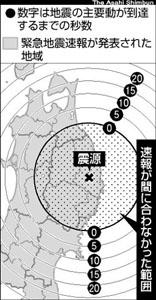After a bed-rocking night in Tohoku, news hit both domestically and internationally of another major earthquake in the region only a month after the massive 7.2 tremor that rocked Miyazaki Prefecture in June. Although the reports all universally documented the essentials of the quake, the Japanese media has picked up on the early warning system employed during the recent quakes, and it's inability to perform correctly during last night's event.
 The number of seconds available between warning and quake. The center shaded area is where the warning was too late. (Courtesy Asahi Shinbun)A service of the Japan Meteorological Agency (JMA), the Earthquake Early Warning system detects P waves or primary tremors that eminate from the epicenter of a quake, estimates the intensity then broadcasts a warning over television and radio in the affected area, presumably a few tens of seconds before the more powerful S waves arrive. The system was put into action beginning October 2007, and was praised by residents of the Tohoku area when it gave many of them almost 20 seconds to react before the quake last month.
The number of seconds available between warning and quake. The center shaded area is where the warning was too late. (Courtesy Asahi Shinbun)A service of the Japan Meteorological Agency (JMA), the Earthquake Early Warning system detects P waves or primary tremors that eminate from the epicenter of a quake, estimates the intensity then broadcasts a warning over television and radio in the affected area, presumably a few tens of seconds before the more powerful S waves arrive. The system was put into action beginning October 2007, and was praised by residents of the Tohoku area when it gave many of them almost 20 seconds to react before the quake last month.
Last night, however, according to NHK and several other news sources, by the time the warning was broadcast the earthquake had already begun to occur near the epicenter in Iwate and Aomori prefectures. Although it has originally been speculated that the warning system would be ineffective near the epicenter due to the short distance between the P and S waves, according to the Yomiuri it took the JMA over 20 seconds after the earthquake had been detected to release the warning to the public. On top of that, although the quake had initially been estimated to be less than magnitude 5 (on the shindo scale), the actual quake measured over 6 (reportedly 6.8 on the Richter scale).
In areas less affected by the quake, such as the already-ravaged Miyazaki Prefecture, about 20 seconds were available between the release of the warning and the quake itself. Even so, it's likely very few were even awake to receive the early warning. The JMA reports that at present the technology is stretched to its limits. Perhaps they need to work on getting the job done faster?
Blog:
Other posts by Sarah:







Comments
Janne (not verified)
July 24, 2008 - 14:13
Permalink
Can't make it faster
You can't really make it faster. Certainly not fast enough to give people real warning right around the epicenter.
Most earthquakes occur close to the surface; less than 70km. The P wave travels at about 5km/s, and the S-wave (which is what you're warning for) at about 60% of that. This earthquake was at about 100km depth. That means the P-wave appeared 8 seconds before the S-wave right on top of the epicenter. Even if the detector was right at the epicenter and powered by magic rather than technology, that would give a maximum of 8 seconds.
In practice that 8 seconds is impossible. You have various lags that are completely inevitable. The detection is not instantaneous; you need to observe the P-wave for a short period of time to realize it is the head wave of an earthquake, and make an estimation of the strength; electronics and transmission equipment isn't instantaneous either, but come with short bits of lag that add up (circuit speeds are finite, as are signal transmission times).
20 seconds perhaps sounds a bit long, but I would be extremely surprised if you got the whole chain below ten seconds, especially considering the high system cost of false positive alarms - not monetary costs, but loss of trust in the system, decreasing the warning effectiveness; and the potential of injuries and property damage from emergency shutdowns, emergency train stops and so on.
Sarah
July 24, 2008 - 14:49
Permalink
Indeed, the JMA also
Indeed, the JMA also commented that the depth of this quake made it difficult to accurately estimate the strength and timing of the S waves. An article in the Sankei News does, however, comment that the JMA had actually sent out a warning 4.1 seconds after detection, but finally got around to issuing a public warning 20.8 sections after detection.
(http://sankei.jp.msn.com/affairs/disaster/080724/dst0807240927016-n1.htm)
I think the general feeling is that time was wasted when they could have gotten a public warning out sooner. I personally think people should appreciate the fact that they have a warning system at all.